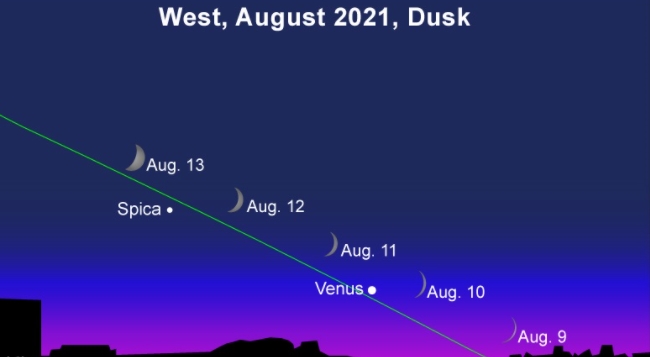EarthSky’s August 2021 Guide To Visible Planets

You’ll need binoculars to see the Mercury-Mars conjunction from the Northern Hemisphere. It’ll be better from the Southern Hemisphere. This chart shows the conjunction as seen from Montevideo, Uruguay, on August 19, 2021. Read more.
Star chart showing moon moving past Jupiter and Saturn in August, 2021.
Watch for the full moon – a Blue Moon – to swing by Saturn and then Jupiter from August 19 to 22, 2021. Although we show Neptune and Pluto on the chart, both are invisible without an optical aid. Read more.
Venus very close to star Spica on dusk horizon along very slanted line of ecliptic with star Arcturus above.
Looking ahead to early September 2021, watch for the close pairing of the planet Venus with Spica, the constellation Virgo’s brightest star, on September 4 and 5, 2021. Read more.
Venus, Mars and Mercury
The bright planet Venus will remain a fixture of our evening sky for the rest of 2021. This is our sky’s brightest planet and it’s very easy to spot in the west after sunset. Two other planets – Mars and Mercury – will be up there as well, but – especially from the Northern Hemisphere – will take a deliberate effort to see. Mars will be easier to find in early August, and Mercury will be easier to find at the end of the month. Mars and Mercury sit beneath Venus, close to the western horizon at dusk. They set before darkness falls. Nominally, both Mars and Mercury reign as evening objects throughout August and September 2021. Realistically, though, these two worlds will be tough to catch in the afterglow of sunset from mid-and-far northern latitudes, even with binoculars.
The Southern Hemisphere has a big advantage in spotting Mars and Mercury. Your best bet is to spot dazzling Venus first, and then seek out these fainter planets below Venus.
Mars starts out the month quite high above Mercury, yet ends the month below Mercury. The two will stage 2021’s closest planetary conjunction on August 19, 2021. Will you see it? Bring along binoculars if you want to try!
Diagram showing solar system from above, with 4 positions of Mercury.
Not to scale. Mercury’s mean distance from the sun is about 0.39 times Earth’s distance from the sun. We’re looking down at the north side of the solar system. In this view, Mercury and Earth circle the sun in a counterclockwise direction. Mercury enters the evening sky (at superior conjunction) on August 1, 2021, and returns to the morning sky (at inferior conjunction) on October 9, 2021. Mercury reaches its greatest eastern (evening) elongation on September 14, 2021. The Southern Hemisphere will enjoy a most spectacular evening apparition of Mercury throughout September 2021.
Watch for the young lunar crescent to return to the evening sky on August 9 or 10. The moon and Venus will present a glorious picture in the evening twilight. From the Southern Hemisphere – on or near August 9 – you might even spot the whisker-thin crescent pairing up with much fainter Mars below Venus. Try your luck with binoculars.
To find out Venus’ or Mars’ or Mercury’s setting time in your sky, go to timeanddate.com or Old Farmer’s Almanac.
Find out both the sunset time and the time of nightfall (end of astronomical twilight) via timeanddate.com.
Read more: What to expect from Mars in 2021
Venus boldly shines in the evening sky for the rest of this year, to reach its greatest elongation from the sun on October 29, 2021 (see diagram below). Moreover, Venus will attain its greatest brilliance as the evening “star” at the time of the new moon on December 4, 2021.
Circle this date on your calendar, and see if it’s true that Venus can cast a shadow on a dark night!
Diagram showing positions of Venus in orbit and its phases at different positions.
In this view, Venus and all the planets travel counterclockwise around the sun. Venus, being an inferior planet, shows phases just like the moon. It swept to the far side of the sun (at superior conjunction) on March 26, 2021, to exit the morning sky and to enter the evening sky. Venus will reach its greatest eastern (evening) elongation from the sun (half Venus) on October 29, 2021. Then on January 9, 2022, Venus will go between the Earth and sun, at inferior conjunction, to exit the evening sky and to enter the morning sky. Image via UCLA.
Jupiter and Saturn
In August 2021, you can see the giant planet Jupiter and ringed planet Saturn from early evening until dawn. They’re at their most glorious this month. Both of them will have an opposition, when they will appear opposite the sun as seen from Earth, in August. Saturn will be at opposition on August 1-2. And Jupiter will be at opposition on August 19-20.
Opposition marks the middle of the best time of year to see a planet. Look for them in your southeast sky at nightfall/early evening, highest up around midnight, and low in the west near sunrise.
Do you have an unobstructed horizon from east to west? If so, look for Venus to blaze away in your western sky at dusk/nightfall. At the same time, you may also view Jupiter and Saturn low in the southeast sky. Some people might catch all three worlds in the same sky as early as August 1. From anywhere worldwide, though, it’ll be easier to see all three planets at dusk/nightfall as the month progresses.
Saturn rises first. Around the world, Saturn rises around sunset at the beginning of the month. At mid-northern latitudes, Jupiter follows Saturn into the sky about an hour (60 minutes) after Saturn comes up. At temperate latitudes in the Southern Hemisphere, Jupiter follows Saturn into the sky around 1 1/2 hours (90 minutes) after Saturn rises.
By around August 20, Jupiter will rise around sunset and set around sunrise. Saturn, which rises before Jupiter, will set about 1 1/2 hours (90 minutes) before Jupiter at mid-northern latitudes. At temperate latitudes in the Southern Hemisphere, Saturn will set about one hour (60 minutes) before Jupiter. Watch for Jupiter to follow Saturn across the nighttime sky throughout August 2021.
For more specific information on when Jupiter and Saturn rise/set in your sky, consult either The Old Farmer’s Almanac (U.S. and Canada) or timeanddate.com (worldwide).
Let the August Blue Moon help guide you to Jupiter and Saturn on August 19-21, 2021.
Which ones are the bright planets?
In their outward order from the sun, the five bright planets are Mercury, Venus, Mars, Jupiter and Saturn. These are the planets easily visible without an optical aid. They’re the planets watched by our ancestors since time immemorial. These planets do appear bright in our sky. They are typically as bright as – or brighter than – the brightest stars. Plus, these relatively nearby worlds tend to shine with a steadier light than the distant, twinkling stars.



 Creators of mankind
Creators of mankind Description of “Tall white aliens”
Description of “Tall white aliens” Where they came from?
Where they came from? About hostile civilizations
About hostile civilizations The war for the Earth
The war for the Earth “Tall white aliens” about eternal life
“Tall white aliens” about eternal life Video: “Nordic aliens”
Video: “Nordic aliens” Aliens
Aliens Alien encounters
Alien encounters The aliens base
The aliens base UFO
UFO Technology UFO
Technology UFO Underground civilization
Underground civilization Ancient alien artifacts
Ancient alien artifacts Military and UFO
Military and UFO Mysteries and hypotheses
Mysteries and hypotheses Scientific facts
Scientific facts


















